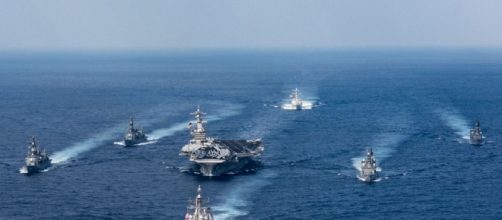When President Donald Trump earlier this week threatened that he had "armada" as a warning to North Korea, a group of warships led by the Aircraft Carrier were still far from the korean peninsula and in the meantime continued to sail in the opposite direction.
Over the weekend, while North Korea showed new missiles in the parade and conducted unsuccessful tests, the armada was even further from the Korean Peninsula. The US command in the Pacific explained that the group should first complete the exercise with Australia which has been shortened but that now it is moving to the western Pacific as ordered.
The perplexing case has provoked reactions from experts on the Korean crisis who are raising the questions of undermining the credibility of Trump's administration, while the US rhetoric regarding the development of North Korea's nuclear programs raises concerns about the possible conflict.
"If you are threatening, and your threat is not credible it will only undermine your policy. And that would be a logical conclusion based on what just happened," says an expert on North Korea Joel Wit from the University observation "North 38" Johns Hopkins.
The US command in a statement on April 10 announced that Admiral Harry Harris, commander of the fleet in the Pacific, sent an offensive group Carl Vinson "to the north in the western Pacific."
What is the final destination of an aircraft carrier?
World media quoted that the ships are about to reach the destination in one week, and the Navy announced that for security reasons they would not disclose the location of future aircraft carriers.
Defense Minister Jim Mattis meanwhile relativized sending an aircraft carrier, saying that "there is no specific request or special reason for sending the ship over there." He incorrectly stated that the carrier was withdrawn from the exercise in Australia.
The Pentagon subsequently announced that even though the carrier will not dock in the Australian port of Fremantle, the exercise was not canceled.
The US will violently respond to each attack
US Vice President Mike Pence said that Washington would work with its allies and China with economic and diplomatic means to compel improvements. He added that America would "respond forcefully" to any attack. Pence arrived on Tuesday in Tokyo from South Korea, and the Japanese officials confirmed that the US is committed to limiting North Korea's nuclear program.
Speaking from the aircraft carrier USS Ronald Reagan which is currently on maintenance in the port of Yokosuka; Pence said that US intentions are unshakable, as long as North Korea keeps on threatening. "Those who are testing our determination and readiness must know that we will defeat any invaders and override any use of conventional or nuclear weapons with a forceful and efficient American response," Pence announced that all options against Pyongyang are on the table, USA Today reports.
Pence said that he spoke to US President and that by 2020 about 60 percent of the US fleet is going to be in the region and that the role of Japan is growing. Pence also said that the US will protect freedom of navigation and flight in the area of the South China Sea. Pence leaves for Indonesia on Wednesday.

